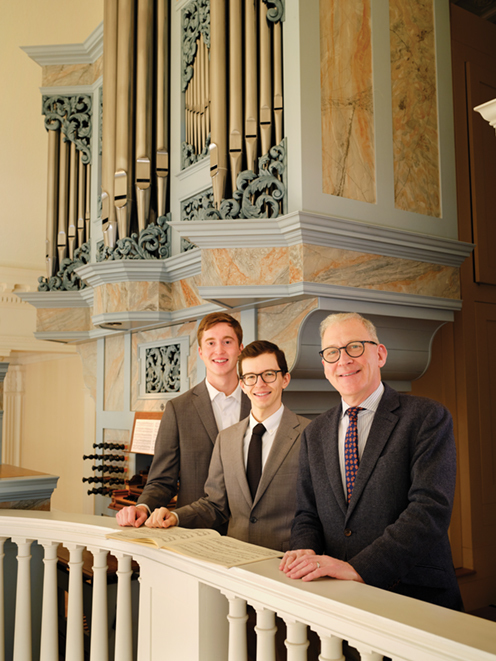
Chris Buck
James O’Donnell (at right), the famed organist and choral conductor who served for over 20 years in Westminster Abbey, left England in 2023 and is now at Yale. He is Professor in the Practice of Organ and Sacred Music. With him are two organ students: Nathan Elsbernd ’20MusM (at left) and Joseph Ferguson ’24MusM.
View full image

Chris Buck
James O’Donnell (at right), the famed organist and choral conductor who served for over 20 years in Westminster Abbey, left England in 2023 and is now at Yale. He is Professor in the Practice of Organ and Sacred Music. With him are two organ students: Nathan Elsbernd ’20MusM (at left) and Joseph Ferguson ’24MusM.
View full image
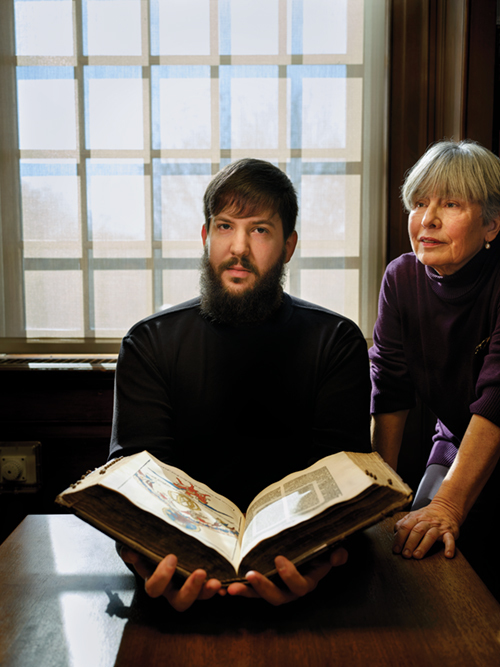
Chris Buck
Jacob Ihnen ’25MDiv is holding a 1493 Latin Vulgate Bible with woodcuts. With him is Teresa Berger, who was born in Germany and taught for 20 years at Duke—but a visit to the Institute of Sacred Music changed her mind. She is now Yale’s Professor of Liturgical Studies and Thomas E. Golden Jr. Professor of Catholic Theology.
View full image

Chris Buck
Jacob Ihnen ’25MDiv is holding a 1493 Latin Vulgate Bible with woodcuts. With him is Teresa Berger, who was born in Germany and taught for 20 years at Duke—but a visit to the Institute of Sacred Music changed her mind. She is now Yale’s Professor of Liturgical Studies and Thomas E. Golden Jr. Professor of Catholic Theology.
View full image
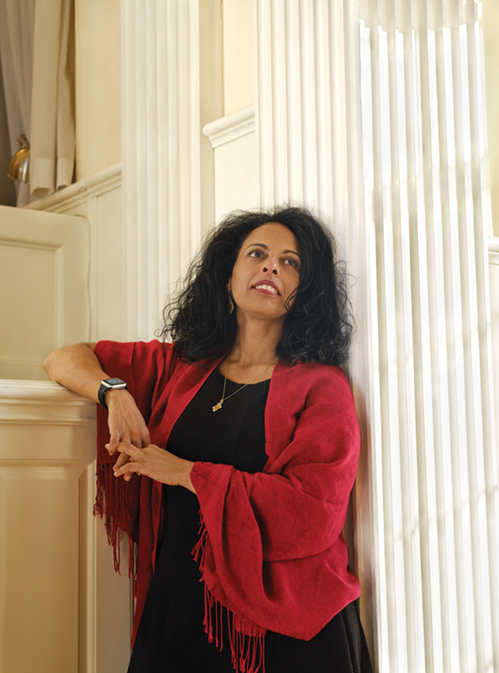
Chris Buck
Awet Andemicael ’10MAR says ISM became her “institutional home.” It was also the place where she found that the questions she’d had were theological questions. She is the associate dean of Marquand Chapel and assistant professor (adjunct) of theology.
View full image

Chris Buck
Awet Andemicael ’10MAR says ISM became her “institutional home.” It was also the place where she found that the questions she’d had were theological questions. She is the associate dean of Marquand Chapel and assistant professor (adjunct) of theology.
View full image

Chris Buck

Chris Buck

Chris Buck
Sarah Shapiro ’24MusM, choral conducting
View full image

Chris Buck
Sarah Shapiro ’24MusM, choral conducting
View full image

Chris Buck

Chris Buck
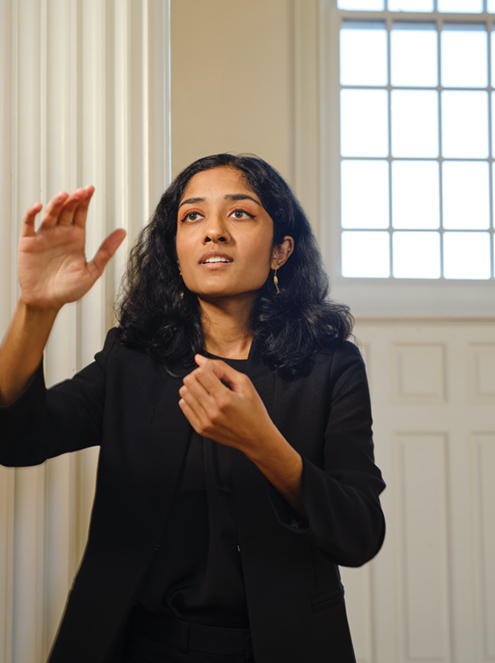
Chris Buck
Mahima Kumara ’25MusM, choral conducting
View full image

Chris Buck
Mahima Kumara ’25MusM, choral conducting
View full image
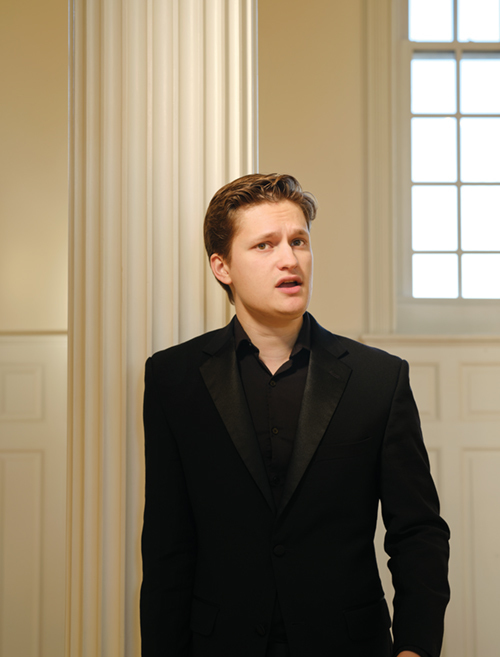
Chris Buck
Michaël Hudetz ’24MusMA, voice
View full image

Chris Buck
Michaël Hudetz ’24MusMA, voice
View full image

Chris Buck

Chris Buck
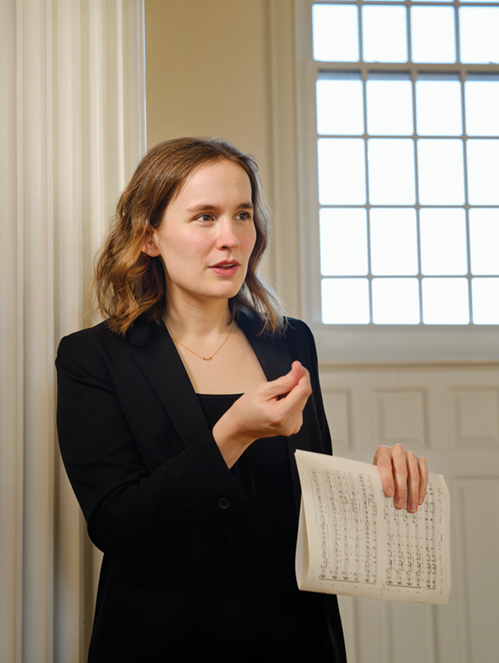
Chris Buck
Margaret Winchell ’28MusAD, choral conducting
View full image

Chris Buck
Margaret Winchell ’28MusAD, choral conducting
View full image

Chris Buck
Alexander Strauss-Fausto ’24MusM, organ
View full image

Chris Buck
Alexander Strauss-Fausto ’24MusM, organ
View full image

Chris Buck
Andrew Liu ’24MusM, choral conducting
View full image

Chris Buck
Andrew Liu ’24MusM, choral conducting
View full image

Chris Buck

Chris Buck
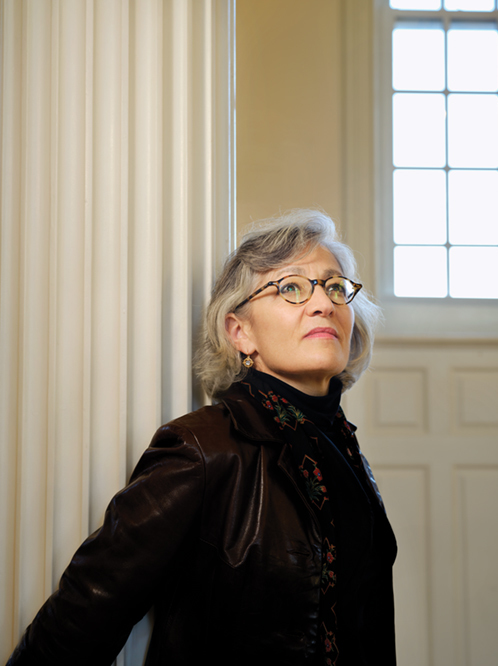
Chris Buck
Nora Heimann ’26MDiv, whose focus is on the visual arts
View full image

Chris Buck
Nora Heimann ’26MDiv, whose focus is on the visual arts
View full image
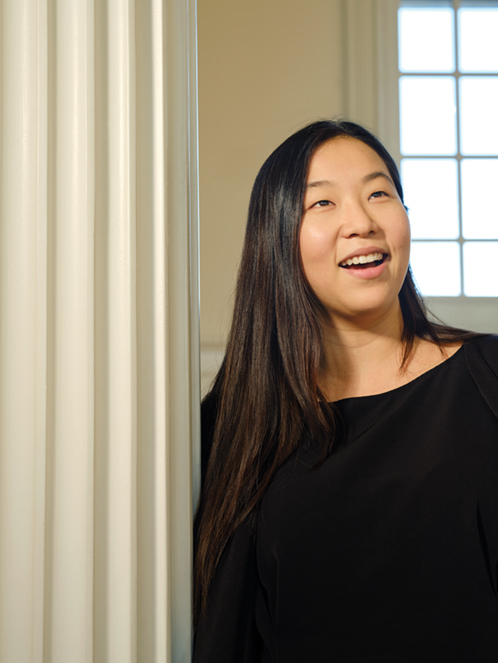
Chris Buck
Eliana Barwinski ’25MAR; her studies are religion and music.
View full image

Chris Buck
Eliana Barwinski ’25MAR; her studies are religion and music.
View full image
When I visited Martin Jean, late in 2023, he was in his 18th year as the director of the Institute of Sacred Music. 2023 also happened to mark the 50th anniversary of the ISM. I mentioned that milestone to Jean, and he nodded. “The anniversary is happening,” he said. “The celebration?” He shrugged. There would be an anniversary party later on. But there was more than enough to do in the meantime.
At Yale, of course, a 50-year-old establishment is a youngster. The Institute of Sacred Music didn’t move into its own house, a 1903 Tudor Revival mansion at the top of Prospect Hill, until 2018. (It was once home to Burton Twitchell, Yale’s dean of students—and brother-in-law of Charles Ives, one of Yale’s most famous musical sons. The other: Cole Porter, 1913BA.)
The move was short in distance—literally across the street from its former home in the Divinity School’s Sterling Quadrangle—but, perhaps, long on symbolism. The ISM is affiliated with both the Divinity School and the School of Music, but it is its own establishment, with its own distinct, interdisciplinary mission.
From the outside, that mission can seem varied to the point of diffusion: not just the study of sacred music, but the full range of sacred expression, how it works and has worked, how it might function in liturgy, as ritual, as artifact and phenomenon, as a calling, as a mystery. But Jean lays it out with geometric clarity: “Three concentric circles.” (Any resemblance to Dante’s conception of heaven—or hell—is probably coincidental.)
The center is professional education: “We train future church musicians and clergy in Christian music for Christian churches,” Jean says. “But we also train scholars, performers, teachers, artists in the practices of the so-called Christian sacred arts. That’s another concentric circle.” Beyond that, an ever-widening frontier. “We have the potential of studying and supporting the practices of sacred arts in every major religious tradition in the world of any time and place. So that’s quite a big mission.” As director, Jean has made the outer circle a priority. But it’s anchored by the original mission—a mission that predates the ISM.
The house on Prospect Street is now named for the people who were instrumental in bringing the Institute to Yale in 1973: J. Irwin Miller ’31 and his sister, Elizabeth Clementine Miller Tangeman. Miller, a longtime member of the Yale Corporation, was both an adherent and an aesthete, combining Midwestern convention, pragmatism, and individualism. He expanded his family’s engine company into a billion-dollar multinational, then used much of the resulting fortune for funding artistic endeavors. He himself was a violinist, eventually owning both a Stradivarius and a Guarneri, playing along to music-minus-one records of classical repertoire. He was the first lay president of the National Council of Churches, and he promptly allied the organization with the civil rights movement. They joined other mainline American Protestant churches in the March on Washington in 1963. His family had built a church, but when the preacher there criticized such ecumenism, Miller simply left and founded another church.
Tangeman’s philanthropy was similarly pious and progressive. She was a trustee of the Christian Theological Seminary in Indianapolis and a national and international leader in the Girl Scouts. She and her brother were particular supporters of New York’s Union Theological Seminary, where Tangeman’s husband was a professor.
In the 1960s, under the leadership of organist and scholar Robert Baker, Union’s School of Sacred Music was a recognized paragon of liturgical training. However, Union was buffeted by the decade’s politics, and its finances suffered. The School of Sacred Music was stretched thin, with departing faculty not replaced, and organs and facilities deteriorating.
Finally, in 1972, Baker spelled out the situation in a memo to Union’s leadership: without an increase in budget and capital investment, the School of Sacred Music was better off closed. Miller and Tangeman, hitherto reluctant to fund a similar effort at Yale, now “pounced,” as Jean puts it. They negotiated a transfer of personnel and endowments and gave Yale an additional ten million dollars to get the new institute on its feet. Space was found in the Divinity School’s old gymnasium. Baker, two other faculty, and an administrator decamped for New Haven. Advertisements appeared in scholarly and theological journals introducing the ISM, featuring a new logo—a two-headed eagle—and a new motto: Phoenix resurgens.
In a memo to Baker, Miller outlined his vision for the ISM. “Christian concepts transcend man and all his little tools,” Miller wrote. “So he needs to use and exploit to the full every sense if he is to come close to getting a handle on Christianity. The arts are therefore not an ornament—but an absolute necessity to the Christian experience.” It was a broad mandate for a program that, at first, largely continued the core task of training organists and choir directors for mainline Protestant churches. But, Jean suspects, Miller and Tangeman “knew that setting this mission in a great research university would change the possibilities immensely.”
The logo changed as well, with the dicephalus eagle replaced by a medieval rendering of King David and his harp. But the bird’s spirit still hovers over the ISM: in flight, forever on the move, eyes on both the past and the future.
The institute’s newest faculty member has been a fixture. James O’Donnell was the organist and choirmaster at Westminster Abbey for 22 years, in musical charge of everything from daily Evensong, to weekly services, to functions of state—up to and including the funeral of Queen Elizabeth II. O’Donnell led the music for one last Christmas service and then arrived at Yale in 2023. He considers it, he says, “a change of focus, but not a fundamental change. As a practitioner of church music in a church or a cathedral foundation, which I’ve been in all my working life so far, I’ve always found there’s quite a big element of teaching.”
To O’Donnell, the appeal of the ISM is its place at the nexus of so much scholarly activity, which “presses a lot of my own sort of personal buttons. It’s multidisciplinary. It involves people, in a wide variety of fields and specialities, coming together and sharing ideas and working in fairly close proximity to each other.” After his first six months, O’Donnell’s main impression of the Institute was positively protean. “It’s like a kaleidoscope,” he says. “It’s always shifting.”
It’s a kind of serendipity that the ISM has, over the years, worked hard to create. Margot Fassler, Jean’s predecessor as director, did much not only to expand the ISM, but also to turn it outward—more students, more public programming, more visiting scholars. Fassler introduced a visiting ethnomusicology fellowship that, under Jean, expanded to encompass varied disciplines and faith traditions, yearly cohorts of new eyes, new angles, new ideas.
O’Donnell appreciates the way the ISM formally designs for informal inspiration. “You suddenly have a conversation with somebody, or you come across a paper that somebody’s presented,” he says, “and it gives you an idea about going in a direction that you’ve never even been aware of—let alone thought of going down before.” The result is the realization of a goal familiar to any church music director: regular revelation. “It keeps you sharp.”
Awet Andemicael ’10MAR found her calling in that community. The recently appointed assistant dean of Marquand Chapel arrived at the Institute on a different path altogether. “I came specifically for music, not for theology,” she says. “At that point, I didn’t really know what theology was as an academic discipline.” Andemicael was a full-time musician, a soprano who found herself singing a lot of sacred music in concert: “I thought it would be good for me to kind of deepen that.” Instead, she found in the ISM an “institutional home. It was a place where I could bring together the different parts of who I am: my interest in music performance, but also the questions that I had, which, I discovered, were actually theological questions.” In the ISM’s manifold community, “all those pieces came together.”
O’Donnell and Andemicael found what they were looking for; Teresa Berger wasn’t even looking. The German-born and German-educated theologian had been teaching at Duke University for two decades when a position opened up at the ISM. Berger politely told the Institute that she wasn’t interested. There followed the academic version of soft selling: an invitation to come and present a paper. “Over the course of a couple of days, things changed, substantially. I realized what a unique place it was,” Berger recalls, “its insistent focus on a very rich understanding of interdisciplinarity.”
Since coming to the ISM in 2007, Berger’s work has followed the lines of her prodigious curiosity. She became fascinated by digital and virtual worship. More recently, she’s been looking at the place of cosmology and cosmic visions in historical Christian experience, and the theological dimensions of the current climate crisis.
She tells of a recent trip to the Beinecke to examine Thomas More’s prayer book, which More read and annotated while he was imprisoned in the Tower of London, awaiting his 1535 execution. “When I first studied the book, my Catholic faith told me: this is a contact relic. It was held by someone who died for their faith, for standing up to empire and power. So there, in the Beinecke, I took off my shoes, which is a traditional gesture of reverence.” For Berger, the story embodies both the congruence and dissonance of religious practice in the academy. “I get a rare book, and I study it. But at the same time, I practice faith in the Beinecke, unbeknownst probably to anybody—unless they wondered why the hell I was taking off my shoes in that library room.”
Sometimes, though, the collision is less pleasant. “I’ve had colleagues,” Berger says, who don’t seem to understand. “When I say I’m a Catholic theologian, they’ll say, ‘Oh, I’m sorry to hear that.’” Yale, like so many other universities, was founded to train clergy; but the quest for universal knowledge has rendered the theological just one approach among many, an approach that, to Berger, is too easily overlooked. “What the academy forgets is that the majority of human beings on the face of the globe practice faith with their own rituals, with their own sonic words, with their own artistic expressions,” she says. “A scholarly world that thinks it can study the world and the universe without attending to that is laughable.”
Jonathan Berryman ’96MusM is also attentive to language. Sitting outside a coffee shop on Audubon Street, he wryly criticizes modern tendencies in biblical translation, using Psalm 23 as an example. “It’s not ‘I will not want,’” he says. “It’s ‘I shall not want.’ There’s intent there. It’s not saying it might happen. It’s saying it’s going to happen.”
Intention and expectation: that’s what Berryman learned at the ISM. His concentration was on music. He became a member (and, later, an assistant conductor) of the Yale Camerata, the ISM’s premier choir, founded and led by Marguerite Brooks. He remembers coming to his first Camerata rehearsals and realizing that Brooks wasn’t going to warm up the choir: “It was your job to be ready.” The focus was on the music.
It was a rarefied atmosphere, to be sure, but even that was a kind of mandate. The university’s resources and facilities allowed unusual latitude in musical pursuits, but forestalled any excuse not to execute at the very highest level. Berryman thrived. “I liked being elite,” he says. He laughs. “It was like being recruited for the CIA. You’re part of an elite squad.” That might have been the most important lesson: the ever-present possibility—and expectation—of excellence. “It’s knowing that this is what music can be. Experiencing that. You can’t know the idea until you have the idea.”
It was the rigor that drew Debi Wong ’10MusM to the ISM. A classically trained singer, Wong had seen her relationship with performance frayed when she was an undergraduate, and she considered a pivot to musicology. A friend convinced her that the ISM could bring together both practices. “I really like working in many different modes,” Wong says. “Part of me really likes to study and understand the context in which all these pieces that I was performing were created—how we can sing something that Bach created and make it connect to things that are happening today.”
Wong started re:Naissance Opera in Vancouver in 2014. It’s a company that marries Baroque opera and modern contexts and production: a music-theatrical realization of the interdisciplinary ethos she absorbed at the ISM. She staged the company’s first commission, Sanctuary & Storm, with music composed by another ISM alumna, Tawnie Olson ’99MusM, ’00MusAD. The opera is about the medieval abbess and composer Hildegard of Bingen.
Berryman, a native of Virginia, has made New Haven his home. He’s the music director at Messiah Baptist Church in Bridgeport. He’s the founder and director of the Heritage Chorale of New Haven and is planning the choir’s post-pandemic revival. He’s not going anywhere: “I have to be here for the next generation.” And the next generation will be held to a high standard. Berryman’s middle-school honors choir? You’d better believe they came to rehearsal already warmed up.
Ask about the place of the ISM in a world that seems increasingly secular, and Jean pushes back hard. “It may be the case that religious traditions don’t have the kind of influence they do in New England or the Northwest,” he says. “But they certainly do in the South of the United States. They certainly do in Latin America, in Africa, where Christianity is growing more quickly than any other religion and any other religious tradition in the world. If you go to South Asia, you’re going to encounter a billion Hindus and Muslims.” It’s what drives Jean to expand the intellectual breadth of the ISM. “Yale, as a global university, has, in the very fabric of its soul, a global mission, and the Institute strives to support that.”
The outermost circle continues to expand. The latest group of ISM fellows are researching everything from the religious ethics of biodiversity to the melting pot of vernacular Tamil music to the singing of the Torah in North Africa. The newest initiative—the Interdisciplinary Program in Music and the Black Church—which brings Yale’s Department of African American Studies into the ISM’s affiliate orbit, is now in its third year. If the scope of the Institute has gone far beyond its mainline organ-and-choir origins, it’s because the academy has come to recognize that no single theory can encompass human spiritual life.
“The United States is increasingly a religiously pluralistic place,” Jean says. “I want my students to understand something about Koranic cantillation just so they understand how the human voice praises in all kinds of cultural settings. I want them to understand what the difference is between saying an Isaac Watts metrical psalter and hearing the call to prayer—what that is, and how they’re similar and different.” The aim is both principled and pragmatic. “For an organist training to work in a large Presbyterian tall-steeple church, to understand the musical traditions of a neighboring Black church is an astonishingly enriching thing.”
“Things have changed drastically,” says Berger. “We now want to know: how does a grandmother pray at her kitchen table every morning? What about the Hispanic women who, on their knees, go to a site of pilgrimage?” The full variety of religious experience is waiting to be studied, “but those are not practices you get to by studying an official ritual book. You can still think of it as worship, but it’s now a much, much broader idea than what it was before.”
Berryman has seen, up close, the need to change what sacred music is and can be. “I know what works for older people,” he says. “I know what works for me. But it’s not palatable to a lot of young people.” The solution? “Diversity,” Berryman says, simply. The challenge is to incorporate the new styles, the new sources, without sacrificing the demand for excellence.
And the pursuit of excellence never ends—even in the ISM’s core mission. After fifty years, “I still think we’re not doing all we can to support classical church music,” Jean says. “We can train our students even better than what we’ve done.”
It’s a Wednesday night. Woolsey Hall is dark, except for the glow from the Newberry organ console. A student is practicing—a modern piece this time: novel sounds on an antique interpretation of an ancient instrument. It’s the Institute of Sacred Music. It’s the past. It’s the present. It’s the future.
 loading
loading